Chenliang Xu
PromptReverb: Multimodal Room Impulse Response Generation Through Latent Rectified Flow Matching
Oct 25, 2025Abstract:Room impulse response (RIR) generation remains a critical challenge for creating immersive virtual acoustic environments. Current methods suffer from two fundamental limitations: the scarcity of full-band RIR datasets and the inability of existing models to generate acoustically accurate responses from diverse input modalities. We present PromptReverb, a two-stage generative framework that addresses these challenges. Our approach combines a variational autoencoder that upsamples band-limited RIRs to full-band quality (48 kHz), and a conditional diffusion transformer model based on rectified flow matching that generates RIRs from descriptions in natural language. Empirical evaluation demonstrates that PromptReverb produces RIRs with superior perceptual quality and acoustic accuracy compared to existing methods, achieving 8.8% mean RT60 error compared to -37% for widely used baselines and yielding more realistic room-acoustic parameters. Our method enables practical applications in virtual reality, architectural acoustics, and audio production where flexible, high-quality RIR synthesis is essential.
Diagnosing Visual Reasoning: Challenges, Insights, and a Path Forward
Oct 23, 2025Abstract:Multimodal large language models (MLLMs) that integrate visual and textual reasoning leverage chain-of-thought (CoT) prompting to tackle complex visual tasks, yet continue to exhibit visual hallucinations and an over-reliance on textual priors. We present a systematic diagnosis of state-of-the-art vision-language models using a three-stage evaluation framework, uncovering key failure modes. To address these, we propose an agent-based architecture that combines LLM reasoning with lightweight visual modules, enabling fine-grained analysis and iterative refinement of reasoning chains. Our results highlight future visual reasoning models should focus on integrating a broader set of specialized tools for analyzing visual content. Our system achieves significant gains (+10.3 on MMMU, +6.0 on MathVista over a 7B baseline), matching or surpassing much larger models. We will release our framework and evaluation suite to facilitate future research.
Video-LMM Post-Training: A Deep Dive into Video Reasoning with Large Multimodal Models
Oct 06, 2025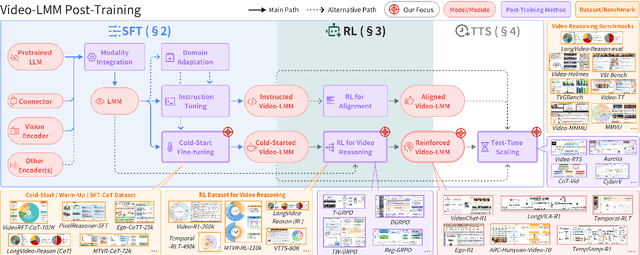
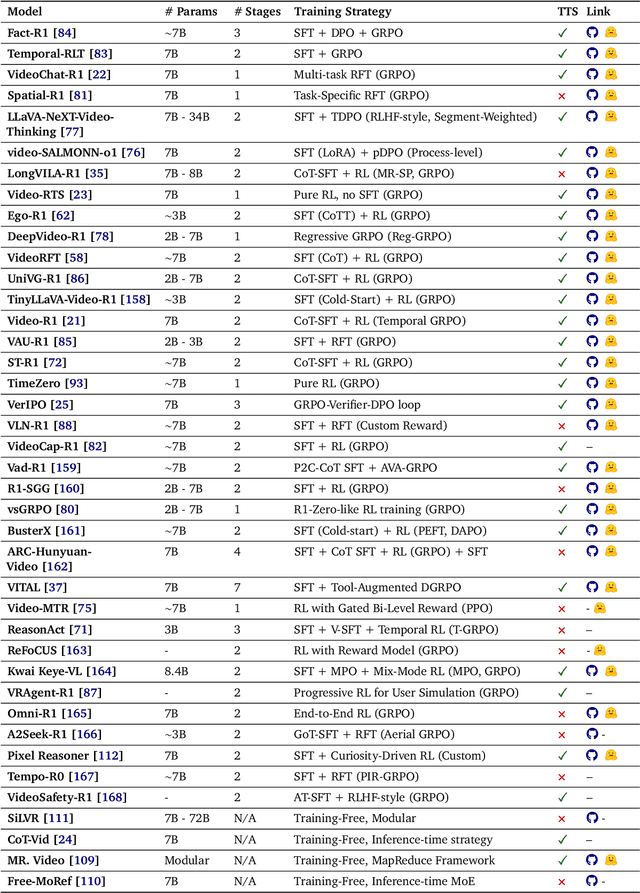
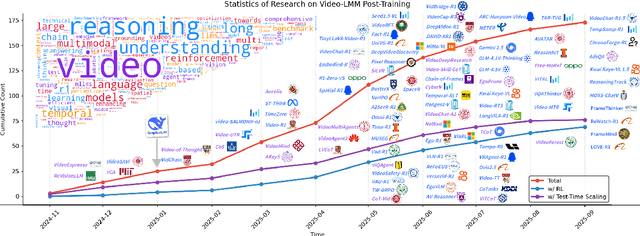
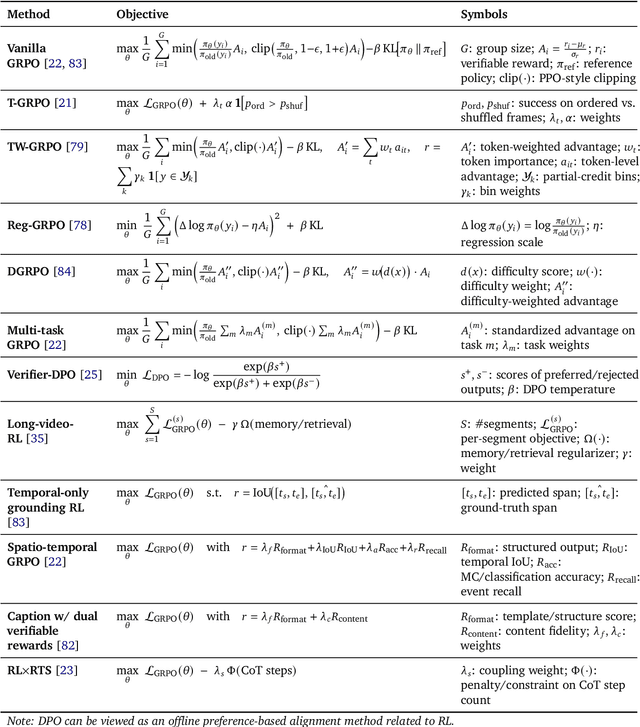
Abstract:Video understanding represents the most challenging frontier in computer vision, requiring models to reason about complex spatiotemporal relationships, long-term dependencies, and multimodal evidence. The recent emergence of Video-Large Multimodal Models (Video-LMMs), which integrate visual encoders with powerful decoder-based language models, has demonstrated remarkable capabilities in video understanding tasks. However, the critical phase that transforms these models from basic perception systems into sophisticated reasoning engines, post-training, remains fragmented across the literature. This survey provides the first comprehensive examination of post-training methodologies for Video-LMMs, encompassing three fundamental pillars: supervised fine-tuning (SFT) with chain-of-thought, reinforcement learning (RL) from verifiable objectives, and test-time scaling (TTS) through enhanced inference computation. We present a structured taxonomy that clarifies the roles, interconnections, and video-specific adaptations of these techniques, addressing unique challenges such as temporal localization, spatiotemporal grounding, long video efficiency, and multimodal evidence integration. Through systematic analysis of representative methods, we synthesize key design principles, insights, and evaluation protocols while identifying critical open challenges in reward design, scalability, and cost-performance optimization. We further curate essential benchmarks, datasets, and metrics to facilitate rigorous assessment of post-training effectiveness. This survey aims to provide researchers and practitioners with a unified framework for advancing Video-LMM capabilities. Additional resources and updates are maintained at: https://github.com/yunlong10/Awesome-Video-LMM-Post-Training
AdvEvo-MARL: Shaping Internalized Safety through Adversarial Co-Evolution in Multi-Agent Reinforcement Learning
Oct 02, 2025Abstract:LLM-based multi-agent systems excel at planning, tool use, and role coordination, but their openness and interaction complexity also expose them to jailbreak, prompt-injection, and adversarial collaboration. Existing defenses fall into two lines: (i) self-verification that asks each agent to pre-filter unsafe instructions before execution, and (ii) external guard modules that police behaviors. The former often underperforms because a standalone agent lacks sufficient capacity to detect cross-agent unsafe chains and delegation-induced risks; the latter increases system overhead and creates a single-point-of-failure-once compromised, system-wide safety collapses, and adding more guards worsens cost and complexity. To solve these challenges, we propose AdvEvo-MARL, a co-evolutionary multi-agent reinforcement learning framework that internalizes safety into task agents. Rather than relying on external guards, AdvEvo-MARL jointly optimizes attackers (which synthesize evolving jailbreak prompts) and defenders (task agents trained to both accomplish their duties and resist attacks) in adversarial learning environments. To stabilize learning and foster cooperation, we introduce a public baseline for advantage estimation: agents within the same functional group share a group-level mean-return baseline, enabling lower-variance updates and stronger intra-group coordination. Across representative attack scenarios, AdvEvo-MARL consistently keeps attack-success rate (ASR) below 20%, whereas baselines reach up to 38.33%, while preserving-and sometimes improving-task accuracy (up to +3.67% on reasoning tasks). These results show that safety and utility can be jointly improved without relying on extra guard agents or added system overhead.
High-Quality Sound Separation Across Diverse Categories via Visually-Guided Generative Modeling
Sep 26, 2025Abstract:We propose DAVIS, a Diffusion-based Audio-VIsual Separation framework that solves the audio-visual sound source separation task through generative learning. Existing methods typically frame sound separation as a mask-based regression problem, achieving significant progress. However, they face limitations in capturing the complex data distribution required for high-quality separation of sounds from diverse categories. In contrast, DAVIS circumvents these issues by leveraging potent generative modeling paradigms, specifically Denoising Diffusion Probabilistic Models (DDPM) and the more recent Flow Matching (FM), integrated within a specialized Separation U-Net architecture. Our framework operates by synthesizing the desired separated sound spectrograms directly from a noise distribution, conditioned concurrently on the mixed audio input and associated visual information. The inherent nature of its generative objective makes DAVIS particularly adept at producing high-quality sound separations for diverse sound categories. We present comparative evaluations of DAVIS, encompassing both its DDPM and Flow Matching variants, against leading methods on the standard AVE and MUSIC datasets. The results affirm that both variants surpass existing approaches in separation quality, highlighting the efficacy of our generative framework for tackling the audio-visual source separation task.
StreamME: Simplify 3D Gaussian Avatar within Live Stream
Jul 22, 2025Abstract:We propose StreamME, a method focuses on fast 3D avatar reconstruction. The StreamME synchronously records and reconstructs a head avatar from live video streams without any pre-cached data, enabling seamless integration of the reconstructed appearance into downstream applications. This exceptionally fast training strategy, which we refer to as on-the-fly training, is central to our approach. Our method is built upon 3D Gaussian Splatting (3DGS), eliminating the reliance on MLPs in deformable 3DGS and relying solely on geometry, which significantly improves the adaptation speed to facial expression. To further ensure high efficiency in on-the-fly training, we introduced a simplification strategy based on primary points, which distributes the point clouds more sparsely across the facial surface, optimizing points number while maintaining rendering quality. Leveraging the on-the-fly training capabilities, our method protects the facial privacy and reduces communication bandwidth in VR system or online conference. Additionally, it can be directly applied to downstream application such as animation, toonify, and relighting. Please refer to our project page for more details: https://songluchuan.github.io/StreamME/.
Can Sound Replace Vision in LLaVA With Token Substitution?
Jun 12, 2025Abstract:While multimodal systems have achieved impressive advances, they typically rely on text-aligned representations rather than directly integrating audio and visual inputs. This reliance can limit the use of acoustic information in tasks requiring nuanced audio understanding. In response, SoundCLIP explores direct audio-visual integration within multimodal large language models (MLLMs) by substituting CLIP's visual tokens with audio representations and selecting sound-relevant patch tokens in models such as LLaVA. We investigate two configurations: (1) projecting audio features into CLIP's visual manifold via a multilayer perceptron trained with InfoNCE on paired audio-video segments, and (2) preserving raw audio embeddings with minimal dimensional adjustments. Experiments with five state-of-the-art audio encoders reveal a fundamental trade-off. While audio-to-video retrieval performance increases dramatically (up to 44 percentage points in Top-1 accuracy) when audio is projected into CLIP's space, text generation quality declines. Encoders pre-trained with text supervision (CLAP, Whisper, ImageBind) maintain stronger generative capabilities than those focused primarily on audiovisual alignment (Wav2CLIP, AudioCLIP), highlighting the value of language exposure for generation tasks. We introduce WhisperCLIP, an architecture that fuses intermediate representations from Whisper, as well as AudioVisual Event Evaluation (AVE-2), a dataset of 580,147 three-second audiovisual clips with fine-grained alignment annotations. Our findings challenge the assumption that stronger cross-modal alignment necessarily benefits all multimodal tasks; instead, a Pareto frontier emerges wherein optimal performance depends on balancing retrieval accuracy with text generation quality. Codes and datasets: https://github.com/ali-vosoughi/SoundCLIP.
ZeroSep: Separate Anything in Audio with Zero Training
May 29, 2025Abstract:Audio source separation is fundamental for machines to understand complex acoustic environments and underpins numerous audio applications. Current supervised deep learning approaches, while powerful, are limited by the need for extensive, task-specific labeled data and struggle to generalize to the immense variability and open-set nature of real-world acoustic scenes. Inspired by the success of generative foundation models, we investigate whether pre-trained text-guided audio diffusion models can overcome these limitations. We make a surprising discovery: zero-shot source separation can be achieved purely through a pre-trained text-guided audio diffusion model under the right configuration. Our method, named ZeroSep, works by inverting the mixed audio into the diffusion model's latent space and then using text conditioning to guide the denoising process to recover individual sources. Without any task-specific training or fine-tuning, ZeroSep repurposes the generative diffusion model for a discriminative separation task and inherently supports open-set scenarios through its rich textual priors. ZeroSep is compatible with a variety of pre-trained text-guided audio diffusion backbones and delivers strong separation performance on multiple separation benchmarks, surpassing even supervised methods.
BinauralFlow: A Causal and Streamable Approach for High-Quality Binaural Speech Synthesis with Flow Matching Models
May 28, 2025
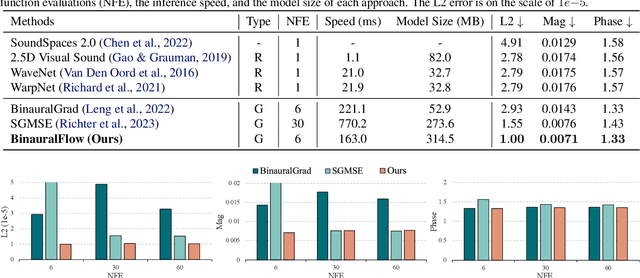


Abstract:Binaural rendering aims to synthesize binaural audio that mimics natural hearing based on a mono audio and the locations of the speaker and listener. Although many methods have been proposed to solve this problem, they struggle with rendering quality and streamable inference. Synthesizing high-quality binaural audio that is indistinguishable from real-world recordings requires precise modeling of binaural cues, room reverb, and ambient sounds. Additionally, real-world applications demand streaming inference. To address these challenges, we propose a flow matching based streaming binaural speech synthesis framework called BinauralFlow. We consider binaural rendering to be a generation problem rather than a regression problem and design a conditional flow matching model to render high-quality audio. Moreover, we design a causal U-Net architecture that estimates the current audio frame solely based on past information to tailor generative models for streaming inference. Finally, we introduce a continuous inference pipeline incorporating streaming STFT/ISTFT operations, a buffer bank, a midpoint solver, and an early skip schedule to improve rendering continuity and speed. Quantitative and qualitative evaluations demonstrate the superiority of our method over SOTA approaches. A perceptual study further reveals that our model is nearly indistinguishable from real-world recordings, with a $42\%$ confusion rate.
MMPerspective: Do MLLMs Understand Perspective? A Comprehensive Benchmark for Perspective Perception, Reasoning, and Robustness
May 26, 2025Abstract:Understanding perspective is fundamental to human visual perception, yet the extent to which multimodal large language models (MLLMs) internalize perspective geometry remains unclear. We introduce MMPerspective, the first benchmark specifically designed to systematically evaluate MLLMs' understanding of perspective through 10 carefully crafted tasks across three complementary dimensions: Perspective Perception, Reasoning, and Robustness. Our benchmark comprises 2,711 real-world and synthetic image instances with 5,083 question-answer pairs that probe key capabilities, such as vanishing point perception and counting, perspective type reasoning, line relationship understanding in 3D space, invariance to perspective-preserving transformations, etc. Through a comprehensive evaluation of 43 state-of-the-art MLLMs, we uncover significant limitations: while models demonstrate competence on surface-level perceptual tasks, they struggle with compositional reasoning and maintaining spatial consistency under perturbations. Our analysis further reveals intriguing patterns between model architecture, scale, and perspective capabilities, highlighting both robustness bottlenecks and the benefits of chain-of-thought prompting. MMPerspective establishes a valuable testbed for diagnosing and advancing spatial understanding in vision-language systems. Resources available at: https://yunlong10.github.io/MMPerspective/
 Add to Chrome
Add to Chrome Add to Firefox
Add to Firefox Add to Edge
Add to Edge